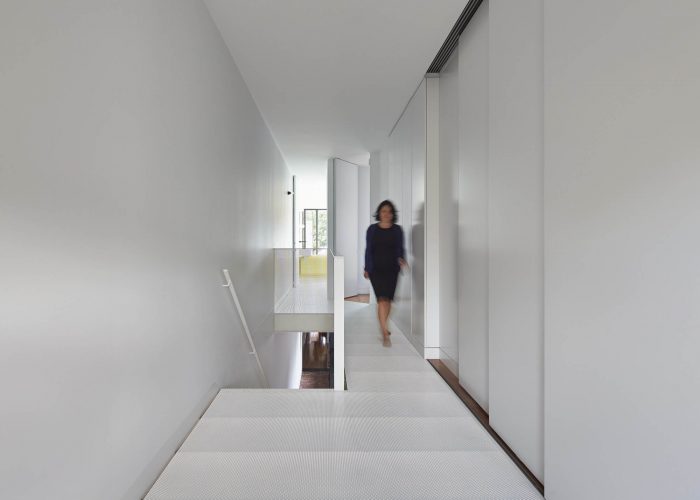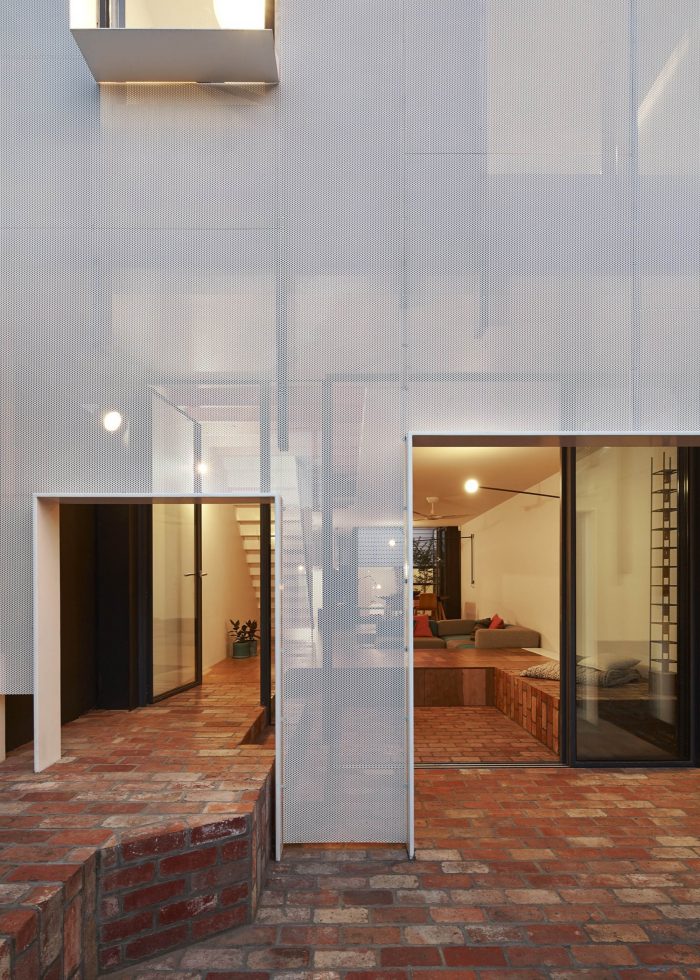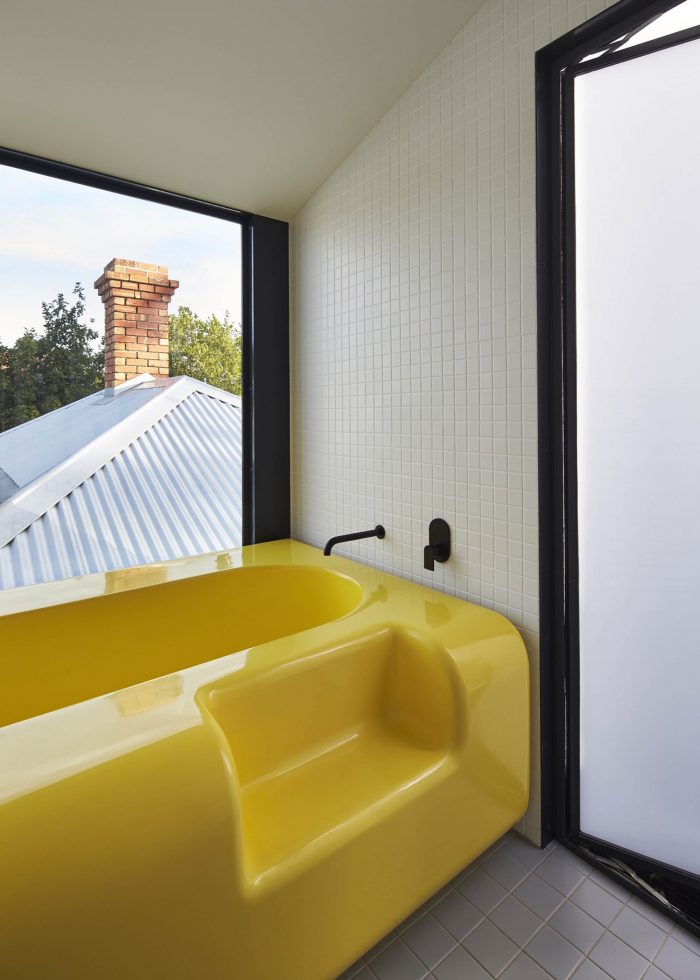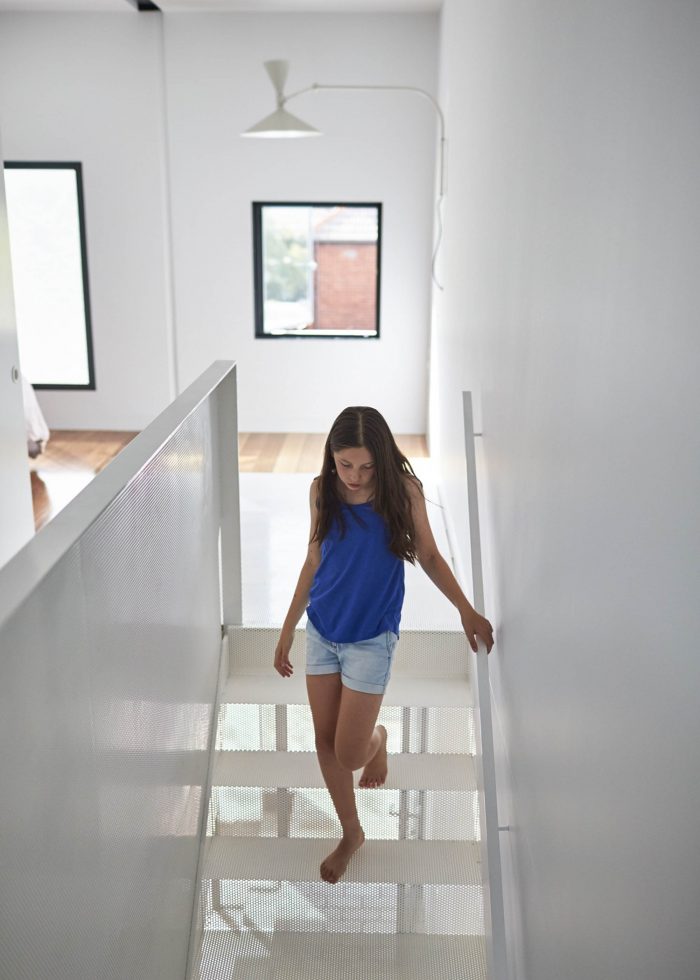概括地说
她是一位高级管理人员,现在是一位新妈妈。为了她和她的新生儿,她希望有一个充满光亮的家,可以隐藏混乱。我们给她的地板是一个巨大的玩具箱。
In a nutshell
She’s a senior executive and now a new mum. For her and her newborn baby she wanted a light-filled home that could hide the mess. We gave her a floor that was a giant toy-box.
是什么。
米尔斯是墨尔本的一个单层风化板露台的扩建项目。原有的外墙和露台的前两个房间仍然保留。其中一个房间已被改变,纳入一个书房和一个浴室。一个大的采光井将原来的结构与新的扩建部分分开。前扩建部分有两间卧室和一间浴室,上面有一个开放的厨房、客厅和餐厅空间。
The what.
Mills is an extension to a one level weatherboard terrace in Melbourne. The original facade and front 2 rooms of the terrace remain. One of those rooms has been altered to incorporate a study and a bathroom. A large lightwell separates the original structure from the new extension. The ex-tension has two bedrooms and a bathroom above an open kitchen, living, dining space.
米尔斯是一个复杂的家,充满了各种想法,但有两个核心要素。
1. 地板是一个巨大的玩具箱。
2. 后面的立面过滤和软化了以前主导后院的强烈阳光。
Mills is a complex home, full of ideas, however there are 2 core elements.
1. The floor is a giant toy box.
2. The rear facade filters and softens the strong sunlight that had previously dominated the back-yard.
地板是橱柜。
每个人都希望有丰富的存储空间。阳台住宅的宽度大致为6米。在加上墙壁、走廊、楼梯、暖气板和橱柜之后,我们留给居住空间的宽度就很少了。如果我们没有墙面上的柜子呢?我们就能在露台的宽度上重新获得近1米的空间。如果我们的储存空间在地板上呢?地板上的空间往往是留给老鼠和蜘蛛的。让我们把地板改造成储物空间,使生活区尽可能大,而不用在墙上挂满笨重的橱柜。
The floor is the cupboard.
Everyone wants an abundance of storage. Terrace homes are roughly 6 metres wide. After adding walls, corridors, stairs, heating panels and cupboards we are left with very little width for living space. What if we didn’t have wall cupboards? We’d get almost 1 metre of space back into the width of our terraces. What if our storage space was within our floor? Floor space is often left to the mice and spiders. Let’s convert the floor into storage space and make the living area as big as pos-sible without lining the walls with bulky cupboards.
除了储存的需要外,我们还关注一个新的婴儿带来的彻底的日常变化。对 “东西 “的无尽管理是关键。地心引力与你的孩子串通一气,对他有利。父母不断地把东西捡起来,而孩子却把它们扔下来。孩子们似乎喜欢把东西掉在地上。我们都见过这样一种折磨人的游戏:坐在高脚椅上的婴儿在玩具被放在他们桌子上的那一刻就把它扔到地上。前三次还很可爱。接下来的200次则是一场噩梦。虽然重力使孩子感到高兴,但它却惩罚了当事人。诀窍是与孩子带来的混乱合作,而不是天真地希望你的孩子会选择整洁。在米尔斯,我们通过在地板上铺设地毯来吞噬所有的混乱,使重力成为父母的同盟而不是孩子的同盟。我们不是把玩具捡起来放回玩具箱,而是把地板变成一个大玩具箱。让我们拿一把扫帚,从顶部和侧面把所有的乐高扫进去。这就成了孩子的一个游戏,也是一个新的玩耍的藏身之处。
Beyond the need for storage we were also concerned with the radical day-to-day changes a new baby brings. The endless management of ‘stuff’ was the key. Gravity is colluding with your child and conspires in its favour. Parents constantly pick things up, whilst kids throw them down. Children seem to love dropping things on the ground. We have all seen the torturous game of a baby sitting in a high chair throwing a toy to the ground the moment it is placed on their table. It’s cute the first three times. It’s a nightmare the next 200 times. While gravity amuses the child, it punishes the par-ent. The trick is to work with the chaos a child brings rather than naively hoping that your child will choose to be neat. At Mills we have made gravity the parents’ ally rather than the child’s by ena-bling the floor to swallow all the mess. Rather than picking toys up to put back in the toy box, we’ve made the floor one big toy box. Let’s get a broom and sweep all the lego in from the top and sides. It becomes a game for the child as well as a new hiding place to play.
450是个神奇的数字。
玩具箱的地板有450毫米深。一个典型的座位大约是450毫米高。开放式地板不仅是存储空间,也是成人舒适的座椅高度的游戏空间。一个kitch-en的长凳大概是900毫米。因此一个厨房的长凳有两个座位高。厨房坐落在原来的地板高度上,因此长凳比新的玩具箱地板高450毫米。厨房的长凳是一个通往新地板的座位。我们在厨房长椅的挡板下垫了一个座位,这样,当有客人来的时候,或者路易斯想和妈妈一起做饭的时候,餐桌上就可以多一个座位。此外,光井花园在新的地板高度上,比长凳的高度低450,这使得接触草药非常容易。450是个神奇的数字。
450 is the magic number.
The toy-box floor is 450 millimetres deep. A typical seat is roughly 450 millimetres high. The open floor is not only storage space, it is also play space at a comfortable seat height for adults. A kitch-en bench is roughly 900 millimetres. Therefore a kitchen bench is two seats high. The kitchen sits on the original floor height therefore the bench is 450 millimetres above the new toy-box floor. The kitchen bench is a seat to the new floor. We’ve upholstered a seat under a flap on the kitchen bench so that there can be one extra seat at the dining table when visitors are over, or when Louis wants to cook with Mum. Furthermore, the lightwell garden is at the new floor height, 450 lower than the benchtop, which makes access to the herbs very easy. 450 is the magic number.
走廊是浪费的空间。
我们喜欢赋予走廊双重功能。米尔斯的厨房占据了原来的走廊空间。因此,厨房在一般情况下会占据的大量空间被用作生活空间。在楼上,主卧室的墙可以完全滑开,这样,房间在向走廊开放时可以增加近2米的长度。
Corridors are wasted space.
We like to give corridors dual functions. The kitchen at Mills occupies the original corridor space. Therefore the substantial space the kitchen would have occupied in a typical location has been used as living space. Upstairs the master bedroom wall can slide entirely away so that the room can increase almost 2 metres in length when open to the corridor.
穿孔金属。
我们在整个米尔斯使用了穿孔金属。楼梯是很棘手的,尤其是在狭小的空间。我们试图创造一种感觉像花边一样轻盈的楼梯,考虑到楼梯所承受的持续活负荷,这是很困难的。打孔的钢板是折叠的,使光线得以共享,同时也实现了从一层到另一层的转换,而不要求你在同一个空间。人们可以在楼上阳光充足的窗户边休息,同时与下面的人进行交谈。虽然这是一个拥有众多空间的小家,但我们通过使用穿孔金属等半透明材料,避免了创造孤立的单元。
Perforated metal.
We’ve used perforated metal throughout Mills. Stairs are tricky, especially in tight spaces. We have tried to create a stair that feels light like lace, which is difficult considering the constant live loads a stair is under. Perforated steel sheet is folded allowing light to be shared while also enabling conver-sations from one level to the other, without requiring you to be in the same space. One can lounge by a sunny upstairs window while having a conversation with someone below. Although it is a small home with numerous spaces, we’ve avoided creating isolated cells by using translucent materials like perforated metal.
我们还采用了穿孔金属来控制阳光。我们都希望家里有充足的阳光,然而过多的阳光使任何家庭都非常不舒服。米尔斯的后门面朝向西北,因此它受到了一天中最强烈的阳光照射。在重新装修之前,业主在她的房子后面感到非常不舒服。我们在后面的立面上铺设了一个白色的围栏式金属立面。外墙在夏天反射了大部分不需要的阳光,允许柔和的过滤光线穿透房子。内部和外部之间的界限已经模糊了。起居室的玻璃墙与外墙相抵,创造了一个舒适的室外空间,感觉就像在房子的皮肤里。在一个明亮、炎热的日子里,外墙给人以坚实和保护的感觉。在昏暗的日子里,在黄昏和傍晚时分,外墙显得不那么坚固,金属皮肤感觉更像是花边而不是墙。
We’ve also employed perforated metal to control sunlight. We all want an abundance of sun in our homes, however too much sunlight makes any home very uncomfortable. The rear facade of Mills faces North-West, therefore it gets hit with the most aggressive sunlight of the day. Before the ren-ovation the owner had felt very uncomfortable at the rear of her house. We’ve draped a white per-forated metal facade down the face of the rear elevation. The facade reflects most of the unwanted sunlight in summer, allowing a soft filtered light to penetrate the house. The lines between inside and outside have been blurred. The glass walls of the living space are offset from the perf facade which creates a comfortable outdoor space that feels as though it is within the skin of the house. The fa-cade feels solid and protective on a bright, hot day. On a dull day, at dusk and in the evening the facade appears far less solid and the metal skin feels more like lace than a wall.
那个浴缸。
浴室不大,因此我们朝采光井和原来的屋顶开了很大的窗户。这使浴室看起来很大,阳光明媚,明亮。
That bathtub.
The bathroom is not big, therefore we have created very large windows towards the lightwell and towards the original roof. This makes the bathroom seem large, sunny and bright.
没有人喜欢打扫浴室。在一个小空间里添加一个浴缸,会产生很多繁琐的细节,污垢、混乱和霉菌都会在这里聚集。为了避免混乱,并创造一个易于维护的浴室,我们用玻璃纤维制作了自己的浴缸。这里没有接缝或连接处。沿着墙壁有一条细长的连续水沟,确保水在浴缸周围流淌,并通过地板排出。简单、整洁、干净。
No one likes cleaning a bathroom. Adding a bathtub to a small space creates a lot of fiddly details where grime, mess and mold can gather. To avoid the mess, and to create a bathroom that was easy to maintain, we made our own bathtub out of fibreglass. There are no seams or joins. Along the walls a slim, continuous gutter that ensure water runs around the bath and drains through the floor. Simple, neat and clean.
可持续性。
像我们所有的建筑一样,可持续性是米尔斯之家的核心。虽然场地不大,但我们已经将所有空间的自然光和空气最大化。开口和窗户的设计都是为了优化被动的太阳辐射,从而大大减少对机械加热和冷却的需求。所有的窗户都是双层玻璃。白色的屋顶大大减少了城市的散热器和内部的热传导。通过主动管理遮阳和被动通风,消除了对空调的需求。一个大型水箱被埋在采光井的中央。所有的屋顶水都被收集并重新用于冲洗厕所和浇灌花园。到处都是高性能的绝缘材料,甚至在原来房子的墙壁上也是如此。在可能的情况下,我们采购了当地的贸易、材料和配件。带有微型逆变器的太阳能电池板覆盖了新的屋顶。
Sustainability.
Like all of our buildings, sustainability is at the core of Mills House. Although the site is small we have maximised natural light and air to all spaces. The openings and windows have been designed to optimise passive solar gain, thereby drastically reducing demands on mechanical heating and cooling. All windows are double glazed. White roofs drastically reduce urban heat sink and heat transfer internally. A need for air-conditioning is eliminated through active management of shade, and passive ventilation. A large water tank has been buried central within the lightwell. All roof water is captured and reused to flush toilets and water the garden. High performance insulation is every-where, even in the walls of the original house. Where possible we have sourced local trades, mate-rials and fittings. Solar panels with micro-inverters cover the new roof.
Architects: Austin Maynard Architects
Area: 154 m²
Year: 2015
Photographs: Peter Bennetts Studio
Builder: Grand Plan Properties
Engineer:Hive Engineering
Design Architect:Andrew Maynard
Project Architects:Mark Austin, Natalie Miles
City:Melbourne
Country:Australia


























